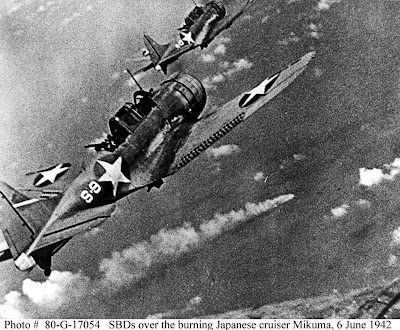The Battle of Midway, fought over and near the tiny U.S. mid-Pacific base at Midway atoll, represents the strategic high water mark of Japan's Pacific Ocean war. Prior to this action, Japan possessed general naval superiority over the United States and could usually choose where and when to attack. After Midway, the two opposing fleets were essentially equals, and the United States soon took the offensive.
Japanese Combined Fleet commander Admiral Isoroku Yamamoto moved on Midway in an effort to draw out and destroy the U.S. Pacific Fleet's aircraft carrier striking forces, which had embarassed the Japanese Navy in the mid-April Doolittle Raid on Japan's home islands and at the Battle of Coral Sea in early May. He planned to quickly knock down Midway's defenses, follow up with an invasion of the atoll's two small islands and establish a Japanese air base there. He expected the U.S. carriers to come out and fight, but to arrive too late to save Midway and in insufficient strength to avoid defeat by his own well-tested carrier air power.
Yamamoto's intended surprise was thwarted by superior American communications intelligence, which deduced his scheme well before battle was joined. This allowed Admiral Chester W. Nimitz, the U.S. Pacific Fleet commander, to establish an ambush by having his carriers ready and waiting for the Japanese. On 4 June 1942, in the second of the Pacific War's great carrier battles, the trap was sprung. The perserverance, sacrifice and skill of U.S. Navy aviators, plus a great deal of good luck on the American side, cost Japan four irreplaceable fleet carriers, while only one of the three U.S. carriers present was lost. The base at Midway, though damaged by Japanese air attack, remained operational and later became a vital component in the American trans-Pacific offensive.
IMAGE LICENSE: This is a World Wide Web site for official information about the Naval History and Heritage Command (NHHC) and naval history. It is provided as a public service by the NHHC. The purpose is to provide information and news about the Naval History and Heritage Command and naval history to the general public.
All information on this site is in the public domain and may be distributed or copied unless otherwise specified. Use of appropriate byline/photo/image credits is requested. Naval History and Heritage Command
This image or file is a work of an employee of the Department of Defense, taken or made during the course of the person's official duties. As a work of the U.S. federal government, the image or file is in the public domain.
Generally speaking, works created by U.S. Government employees are not eligible for copyright protection in the United States. See Circular 1 "COPYRIGHT BASICS" PDF from the U.S. Copyright Office.
TEXT CREDIT: Naval History and Heritage Command

















No comments:
Post a Comment